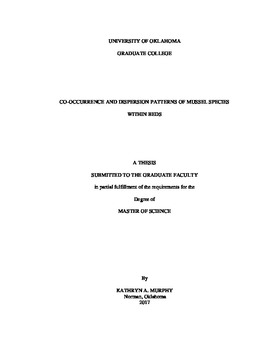| dc.description.abstract | To aid in the conservation of freshwater mussels (Bivalvia, Unionidae), a better understanding of how mussel communities are structured is needed. While we know a great deal about the distribution and abundance of mussels across rivers, we know less about community structure within rivers and within mussel beds and possible mechanisms underlying such structure. I used mussel assemblages from the Little River, Oklahoma, known for its abundant and diverse mussel fauna, to examine patterns of mussel community structure. I semi-quantitatively sampled 42 mussel beds and quantitatively sampled 12 large mussel beds in the summers of 2015 and 2016. At the river scale, I used nestedness analysis to see if the assemblages of small mussel beds were subsets of the assemblages of larger mussel beds. I then used checkerboard analysis to examine patterns of mussel species co-occurrence at two spatial scales, across sites (mussel beds) and within mussel beds. Finally, I used a permutational multivariate analysis of variance to determine if subordinate communities of mussels differed depending on what species was present in a mussel bed. I also examined communities which differed in their total standing crop biomass to determine if the importance of dominant species changed at different biomass levels. I found that mussel communities in the Little River are comprised of several dominant species (Actinonaias ligamentina, Amblema plicata, and Quadrula pustulosa) and a broad suite of less abundant (subordinate) species. These assemblages are highly nested; smaller mussel beds are subsets of larger species rich beds. While subordinate species only occur in beds that contain the dominant species, in this study the identity of the dominant species did not determine the composition of the subordinate community. Instead, the overall biomass of mussel beds determined mussel species composition, with more higher biomass beds of higher biomass supporting a different assemblage of subordinate species than smaller, less productive mussel beds. There were no significant patterns of mussel species co-occurrence either among or within mussel beds. Dominant mussel species may serve as foundation species in the Little River, creating biogenic habitat for other mussel species, and perhaps fish hosts, which leads to increased mussel biomass and species richness as the abundance of the foundation species’ increases. Understanding how mussel communities are structured should aid in conserving and managing these communities in response to climate change and other environmental stressors. | en_US |
